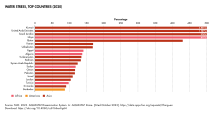This article needs additional citations for verification. (April 2008) |

Center pivot irrigation in Saudi Arabia is typical of many isolated irrigation projects scattered throughout the arid and hyper-arid regions of the Earth. Nonrenewable fossil water is mined from depths as great as 1 km (3,000 ft), pumped to the surface, and distributed via large center pivot irrigation feeds. The circles of green irrigated vegetation may comprise a variety of agricultural commodities from alfalfa to wheat. Diameters of the normally circular fields range from a few hundred meters to as much as 3 km (1.9 mi).
The projects often trace out a narrow, sinuous, and seemingly random path. Actually, engineers generally seek ancient river channels now buried by the sand seas. The fossil waters mined in these projects accumulated during periods of wetter climate in the Pleistocene glacial epochs, between 10,000 and 2 million years ago, and are not being replenished under current climatic conditions. The projects, therefore, will have limited production as the reservoirs are drained.

A network of dams has been built to trap and use precious seasonal floods. Vast underground water reservoirs have been tapped through deep wells. Desalination plants have been built to produce fresh water from the sea for urban and industrial use, thereby freeing other sources for agriculture. Facilities have also been put into place to treat urban and industrial run-off for agricultural irrigation. These efforts collectively have helped transform vast tracts of the desert into fertile farmland. Land under cultivation grew from under 400,000 acres (1,600 km2) in 1976 to more than 8 million acres (32,000 km2) in 1993.
Saudi Arabia is suffering from a major depletion of the water in its underground aquifers and a resultant break down and disintegration of its agriculture as a consequence.[2][3] As a result of the catastrophe, Saudi Arabia has bought agricultural land in the United States,[4][5] Argentina,[6] and Africa.[7][8][9][10] Saudi Arabia ranked as a major buyer of agricultural land in foreign countries.[11][12]
- ^ FAO. 2023. World Food and Agriculture – Statistical Yearbook 2023. Rome. p. 41–42
- ^ "What California can learn from Saudi Arabia's water mystery". 22 April 2015. Retrieved 26 March 2019.
- ^ "Saudi Arabia's Great Thirst". National Geographic. 10 January 2017. Retrieved 26 March 2019.
- ^ RYOT (9 November 2015). "Saudi Farmers Buy Up US Land After Drying Out Theirs". Retrieved 26 March 2019 – via YouTube.[dead YouTube link]
- ^ "Saudi dairy giant Almarai buys agricultural land in USA". english.alarabiya.net. Retrieved 26 March 2019.
- ^ "Saudi firm buys farmland in Argentina to secure animal feed". USATODAY.COM. Retrieved 26 March 2019.
- ^ "Outsourcing's third wave". 21 May 2009. Retrieved 26 March 2019 – via The Economist.
- ^ Wilkerson, Michael. "Why is Saudi Arabia buying up African farmland?". Retrieved 26 March 2019.
- ^ Aburawa, Arwa. "African Land Grab Continues – Middle East Is Major Buyer". Green Prophet. Retrieved 26 March 2019.
- ^ "An incredible image shows how powerful countries are buying up much of the world's land". The Washington Post. 2015-05-21. Retrieved 2019-03-26.
- ^ Khetani, Sanya. "These 14 Countries Are Buying Incredible Amounts Of Foreign Land In Deals You Never Hear About". Business Insider. Retrieved 26 March 2019.
- ^ Demick, Barbara. "China looks abroad for greener pastures". latimes.com. Retrieved 26 March 2019.